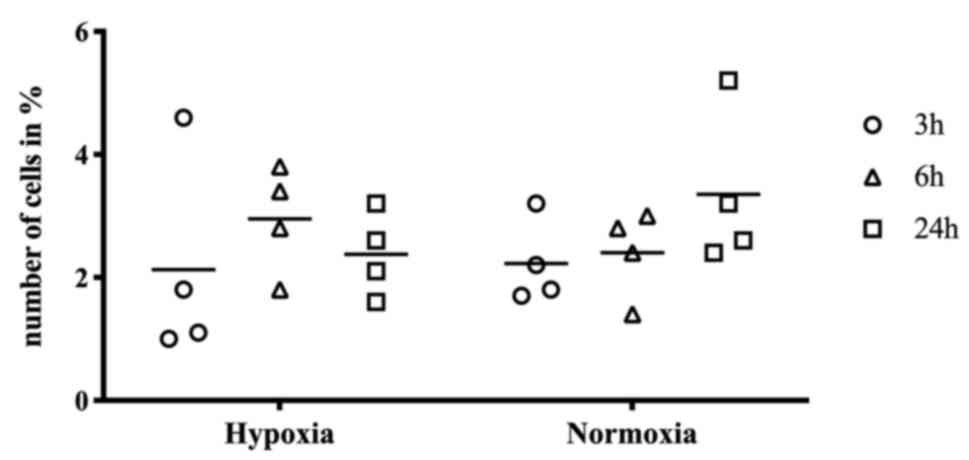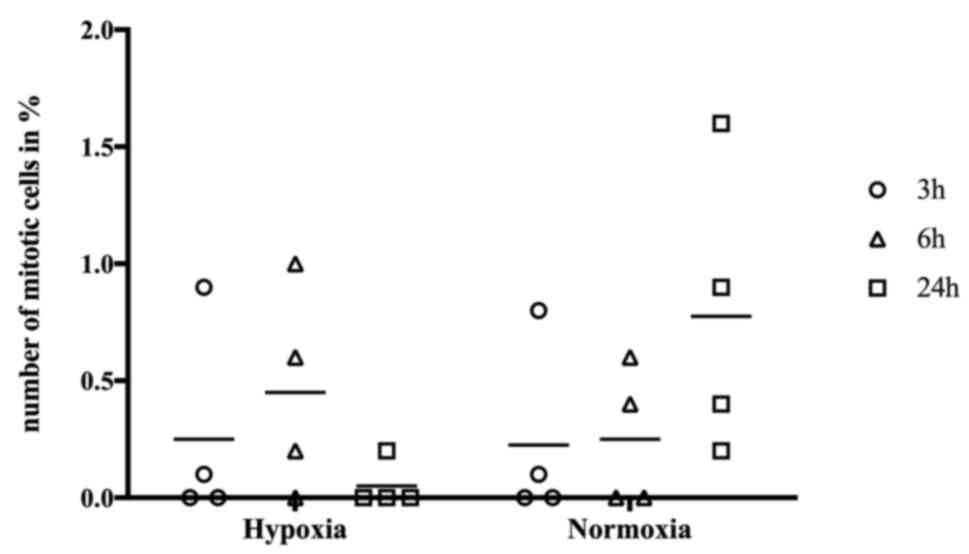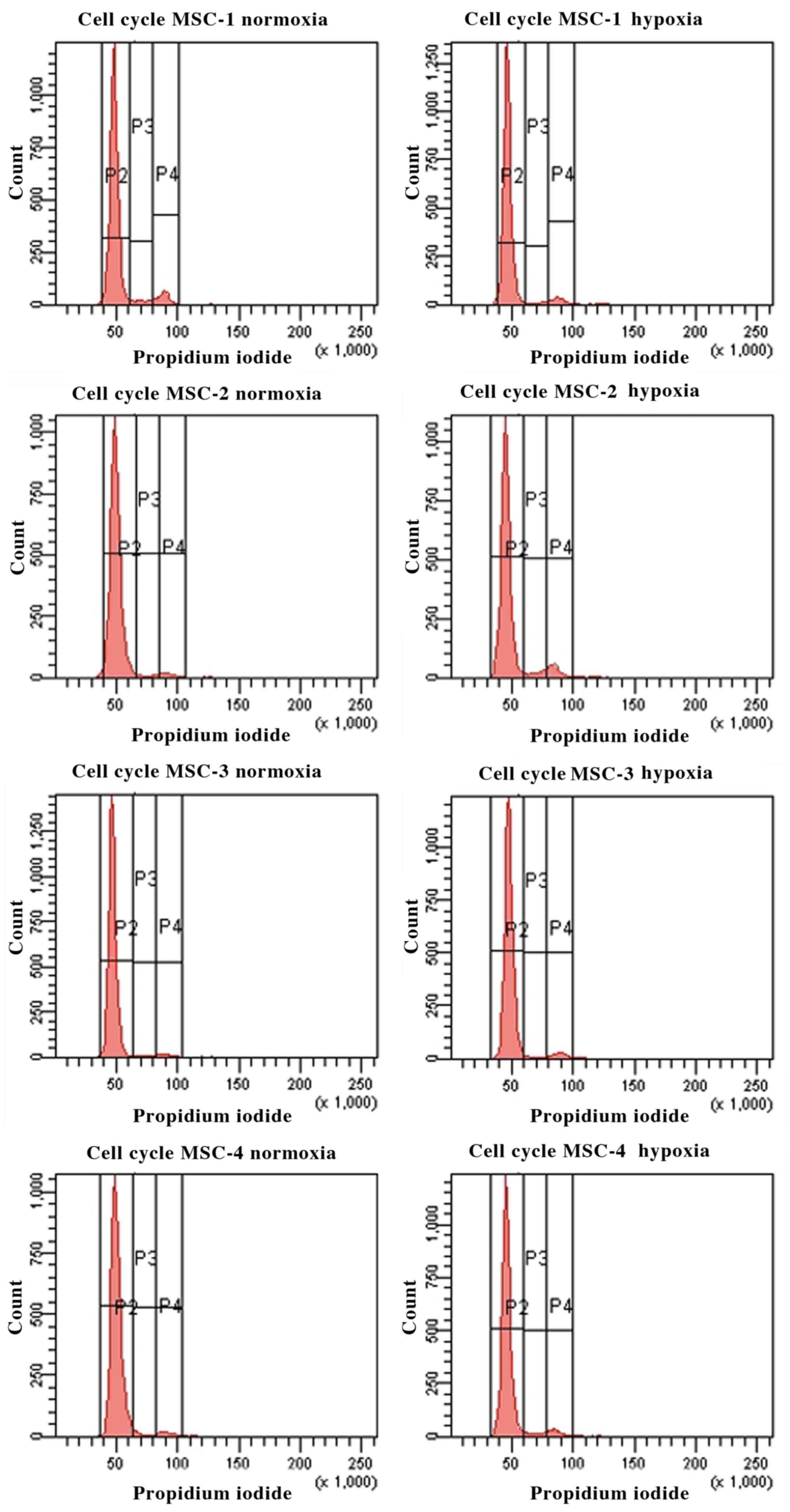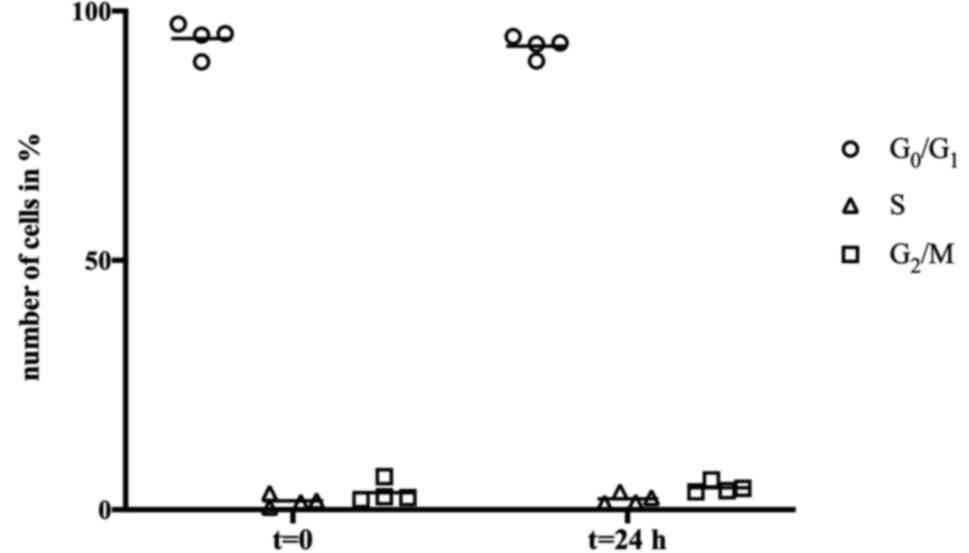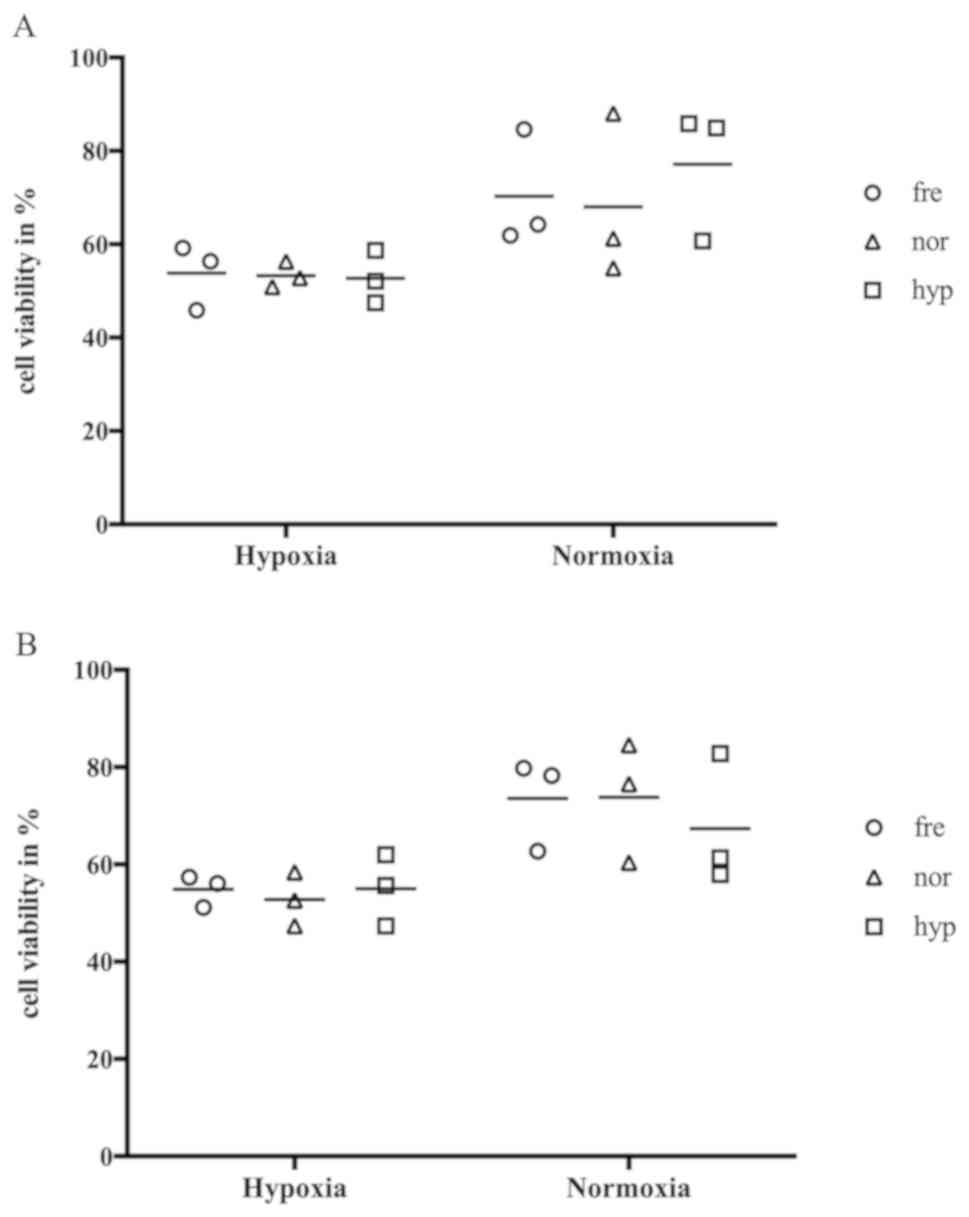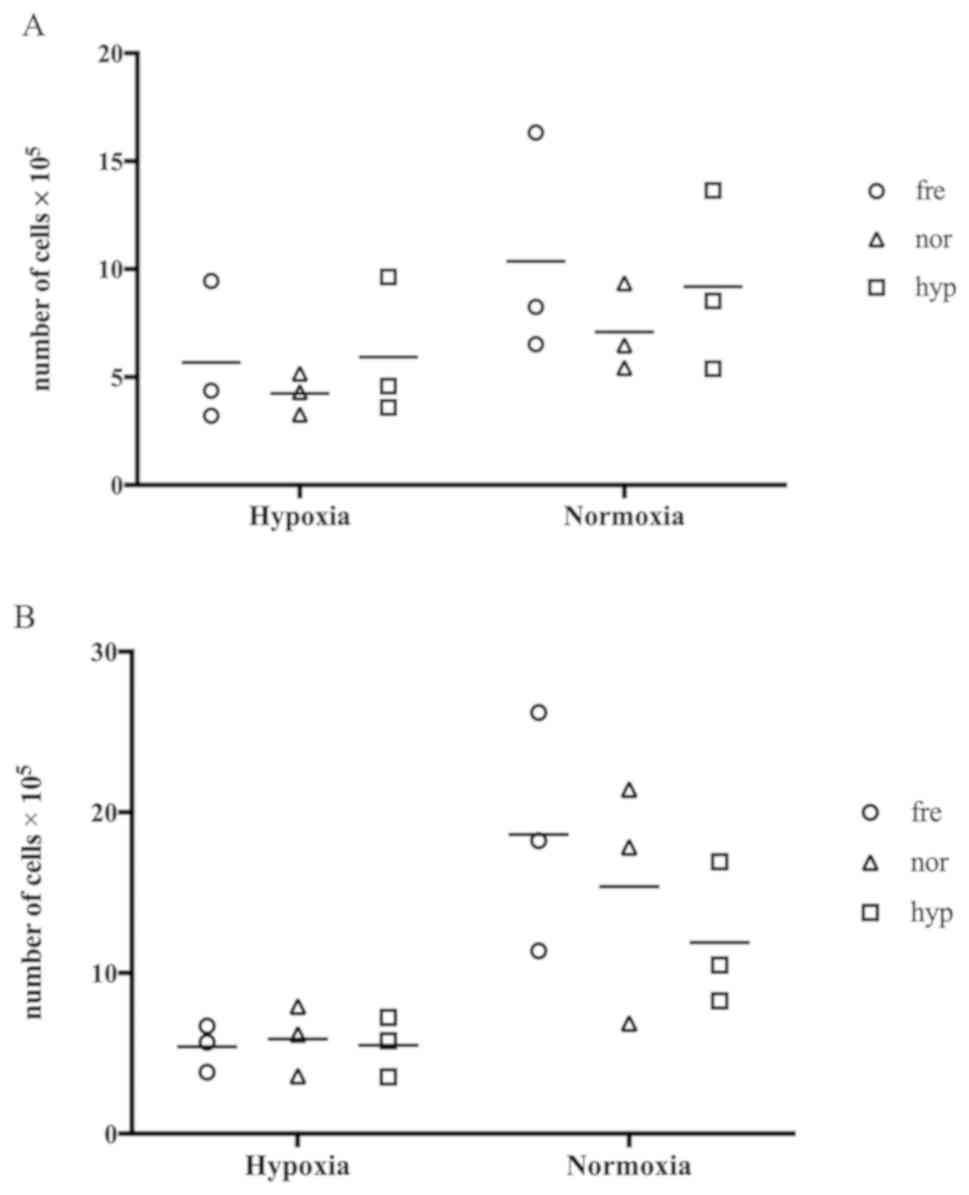|
1
|
Vaupel P, Mayer A and Höckel M: Tumor
hypoxia and malignant progression. Methods Enzymol. 31:335–354.
2004. View Article : Google Scholar
|
|
2
|
Becker A, Hänsgen G, Bloching M, Weigel C,
Lautenschläger C and Dunst J: Oxygenation of squamous cell
carcinoma of the head and neck: Comparison of primary tumors, neck
node metastases, and normal tissue. Int J Radiat Oncol Biol Phys.
42:35–41. 1998. View Article : Google Scholar : PubMed/NCBI
|
|
3
|
Horsman MR, Mortensen LS, Petersen JB,
Busk M and Overgaard J: Imaging hypoxia to improve radiotherapy
outcome. Nat Rev Clin Oncol. 9:674–687. 2012. View Article : Google Scholar : PubMed/NCBI
|
|
4
|
Moritake S, Taira S, Ichiyanagi Y, Morone
N, Song SY, Hatanaka T, Yuasa S and Setou M: Functionalized
nano-magnetic particles for an in vivo delivery system. J Nanosci
Nanotechnol. 7:937–944. 2007. View Article : Google Scholar : PubMed/NCBI
|
|
5
|
Hu YL, Huang B, Zhang TY, Miao PH, Tang
GP, Tabata Y and Gao JQ: Mesenchymal stem cells as a novel carrier
for targeted delivery of gene in cancer therapy based on nonviral
transfection. Mol Pharm. 9:2698–2709. 2012. View Article : Google Scholar : PubMed/NCBI
|
|
6
|
Scherzed A, Hackenberg S, Radeloff A,
Froelich K, Rak K, Hagen R and Kleinsasser N: Human mesenchymal
stem cells promote cancer motility and cytokine secretion in vitro.
Cells Tissues Organs. 198:327–337. 2013. View Article : Google Scholar : PubMed/NCBI
|
|
7
|
Wei X, Yang X, Han ZP, Qu FF, Shao L and
Shi YF: Mesenchymal stem cells: A new trend for cell therapy. Acta
Pharmacol Sin. 34:747–754. 2013. View Article : Google Scholar : PubMed/NCBI
|
|
8
|
Dominici M, Le Blanc K, Mueller I,
Slaper-Cortenbach I, Marini F, Krause D, Deans R, Keating A,
Prockop D and Horwitz E: Minimal criteria for defining multipotent
mesenchymal stromal cells. The international society for cellular
therapy position statement. Cytotherapy. 8:315–317. 2006.
View Article : Google Scholar : PubMed/NCBI
|
|
9
|
Mohammadian M, Shamsasenjan K, Nezhad PL,
Talebi M, Jahedi M, Nickkhah H, Minayi N and Pour AM: Mesenchymal
stem cells: New aspect in cell-based regenerative therapy. Adv
Pharm Bull. 3:433–437. 2013.PubMed/NCBI
|
|
10
|
Malek S, Kaplan E, Wang JF, Ke Q, Rana JS,
Chen Y, Rahim BG, Li M, Huang Q, Xiao YF, et al: Successful
implantation of intravenously administered stem cells correlates
with severity of inflammation in murine myocarditis. Pflugers Arch.
452:268–275. 2006. View Article : Google Scholar : PubMed/NCBI
|
|
11
|
Asahara T, Masuda H, Takahashi T, Kalka C,
Pastore C, Silver M, Kearne M, Magner M and Isner JM: Bone marrow
origin of endothelial progenitor cells responsible for postnatal
vasculogenesis in physiological and pathological
neovascularization. Circ Res. 85:221–228. 1999. View Article : Google Scholar : PubMed/NCBI
|
|
12
|
Crisan M, Yap S, Casteilla L, Chen CW,
Corselli M, Park TS, Andriolo G, Sun B, Zheng B, Zhang L, et al: A
perivascular origin for mesenchymal stem cells in multiple human
organs. Cell Stem Cell. 3:301–313. 2008. View Article : Google Scholar : PubMed/NCBI
|
|
13
|
Spaeth EL, Kidd S and Marini FC: Tracking
inflammation-induced mobilization of mesenchymal stem cells.
Methods Mol Biol. 904:173–190. 2012.PubMed/NCBI
|
|
14
|
Kidd S, Caldwell L, Dietrich M, Samudio I,
Spaeth EL, Watson K, Shi Y, Abbruzzese J, Konopleva M, Andreeff M
and Marini FC: Mesenchymal stromal cells alone or expressing
interferon-beta suppress pancreatic tumors in vivo, an effect
countered by anti-inflammatory treatment. Cytotherapy. 12:615–625.
2010. View Article : Google Scholar : PubMed/NCBI
|
|
15
|
Rhodes LV, Muir SE, Elliott S, Guillot LM,
Antoon JW, Penfornis P, Tilghman SL, Salvo VA, Fonseca JP, Lacey
MR, et al: Adult human mesenchymal stem cells enhance breast
tumorigenesis and promote hormone independence. Breast Cancer Res
Treat. 121:293–300. 2010. View Article : Google Scholar : PubMed/NCBI
|
|
16
|
Khakoo AY, Pati S, Anderson SA, Reid W,
Elshal MF, Rovira II, Nguyen AT, Malide D, Combs CA, Hall G, et al:
Human mesenchymal stem cells exert potent antitumorigenic effects
in a model of kaposi's sarcoma. J Exp Med. 203:1235–1247. 2006.
View Article : Google Scholar : PubMed/NCBI
|
|
17
|
Triaca V, Carito V, Fico E, Rosso P, Fiore
M, Ralli M, Lambiase A, Greco A and Tirassa P: Cancer stem
cells-driven tumor growth and immune escape: The janus face of
neurotrophins. Aging (Albany NY). 11:11770–11792. 2019. View Article : Google Scholar : PubMed/NCBI
|
|
18
|
Madrigal M, Rao KS and Riordan NH: A
review of therapeutic effects of mesenchymal stem cell secretions
and induction of secretory modification by different culture
methods. J Transl Med. 12:2602014. View Article : Google Scholar : PubMed/NCBI
|
|
19
|
Ahluwalia A and Tarnawski AS: Critical
role of hypoxia sensor-HIF-1α in VEGF gene activation. Implications
for angiogenesis and tissue injury healing. Curr Med Chem.
19:90–97. 2012. View Article : Google Scholar : PubMed/NCBI
|
|
20
|
Chang CP, Chio CC, Cheong CU, Chao CM,
Cheng BC and Lin MT: Hypoxic preconditioning enhances the
therapeutic potential of the secretome from cultured human
mesenchymal stem cells in experimental traumatic brain injury. Clin
Sci (Lond). 124:165–176. 2013. View Article : Google Scholar : PubMed/NCBI
|
|
21
|
Li S, Zhang Y, Shao G, Yang M, Niu J, Lv G
and Ji X: Hypoxic preconditioning stimulates angiogenesis in
ischemic penumbra after acute cerebral infarction. Neural Regen
Res. 8:2895–2903. 2013.PubMed/NCBI
|
|
22
|
Yu J, Yin S, Zhang W, Gao F, Liu Y, Chen
Z, Zhang M, He J and Zheng S: Hypoxia preconditioned bone marrow
mesenchymal stem cells promote liver regeneration in a rat massive
hepatectomy model. Stem Cell Res Ther. 4:832013. View Article : Google Scholar : PubMed/NCBI
|
|
23
|
Lavrentieva A, Majore I, Kasper C and Hass
R: Effects of hypoxic culture conditions on umbilical cord-derived
human mesenchymal stem cells. Cell Commun Signal. 8:182010.
View Article : Google Scholar : PubMed/NCBI
|
|
24
|
Lee RH, Kim B, Choi I, Kim H, Choi HS, Suh
K, Bae YC and Jung JS: Characterization and expression analysis of
mesenchymal stem cells from human bone marrow and adipose tissue.
Cell Physiol Biochem. 14:311–324. 2004. View Article : Google Scholar : PubMed/NCBI
|
|
25
|
Rangan SR: A new human cell line (FaDu)
from a hypopharyngeal carcinoma. Cancer. 29:117–121. 1972.
View Article : Google Scholar : PubMed/NCBI
|
|
26
|
Krueger TE, Thorek DL, Denmeade SR, Isaacs
JT and Brennen WN: Concise review: Mesenchymal stem cell-based drug
delivery: The good, the bad, the ugly, and the promise. Stem Cells
Transl Med. 7:651–663. 2018. View Article : Google Scholar : PubMed/NCBI
|
|
27
|
Kucerova L, Altanerova V, Matuskova M,
Tyciakova S and Altaner C: Adipose tissue-derived human mesenchymal
stem cells mediated prodrug cancer gene therapy. Cancer Res.
67:6304–6313. 2007. View Article : Google Scholar : PubMed/NCBI
|
|
28
|
Cavarretta IT, Altanerova V, Matuskova M,
Kucerova L, Culig Z and Altaner C: Adipose tissue-derived
mesenchymal stem cells expressing prodrug-converting enzyme inhibit
human prostate tumor growth. Mol Ther. 18:223–231. 2010. View Article : Google Scholar : PubMed/NCBI
|
|
29
|
Anson DS: The use of retroviral vectors
for gene therapy-what are the risks? A review of retroviral
pathogenesis and its relevance to retroviral vector-mediated gene
delivery. Genet Vaccines Ther. 13:92004. View Article : Google Scholar
|
|
30
|
Fan H and Johnson C: Insertional
oncogenesis by non-acute retroviruses: Implications for gene
therapy. Viruses. 3:398–422. 2011. View Article : Google Scholar : PubMed/NCBI
|
|
31
|
Karnoub AE, Dash AB, Vo AP, Sullivan A,
Brooks MW, Bell GW, Richardson AL, Polyak K, Tubo R and Weinberg
RA: Mesenchymal stem cells within tumour stroma promote breast
cancer metastasis. Nature. 449:557–563. 2007. View Article : Google Scholar : PubMed/NCBI
|
|
32
|
De Wever O and Mareel M: Role of tissue
stroma in cancer cell invasion. J Pathol. 200:429–447. 2003.
View Article : Google Scholar : PubMed/NCBI
|
|
33
|
Hou L, Wang X, Zhou Y, Ma H, Wang Z, He J,
Hu H, Guan W and Ma Y: Inhibitory effect and mechanism of
mesenchymal stem cells on liver cancer cells. Tumor Biol.
35:1239–1250. 2014. View Article : Google Scholar
|
|
34
|
Pevsner-Fischer M, Levin S and Zipori D:
The origins of mesenchymal stromal cell heterogeneity. Stem Cell
Rev Rep. 7:560–568. 2011. View Article : Google Scholar : PubMed/NCBI
|
|
35
|
Melzer C, Yang Y and Hass R: Interaction
of MSC with tumor cells. Cell Commun Signal. 14:202016. View Article : Google Scholar : PubMed/NCBI
|
|
36
|
Dachs GU and Tozer GM: Hypoxia modulated
gene expression: Angiogenesis, metastasis and therapeutic
exploitation. Eur J Cancer. 36:1649–1660. 2000. View Article : Google Scholar : PubMed/NCBI
|
|
37
|
Buravkova LB, Andreeva ER, Gogvadze V and
Zhivotovsky B: Mesenchymal stem cells and hypoxia: Where are we?
Mitochondrion. 19:105–112. 2014. View Article : Google Scholar : PubMed/NCBI
|
|
38
|
Chang W, Song BW, Lim S, Song H, Shim CY,
Cha MJ, Ahn DH, Jung YG, Lee DH, Chung JH, et al: Mesenchymal stem
cells pretreated with delivered hph-1-hsp70 protein are protected
from hypoxia-mediated cell death and rescue heart functions from
myocardial injury. Stem Cells. 27:2283–2292. 2009. View Article : Google Scholar : PubMed/NCBI
|
|
39
|
Basciano L, Nemos C, Foliguet B, de Isla
N, de Carvalho M, Tran N and Dalloul A: Long term culture of
mesenchymal stem cells in hypoxia promotes a genetic program
maintaining their undifferentiated and multipotent status. BMC Cell
Biol. 30:122011. View Article : Google Scholar
|
|
40
|
Liu Y, Ren H, Zhou Y, Shang L, Zhang Y,
Yang F and Shi X: The hypoxia conditioned mesenchymal stem cells
promote hepatocellular carcinoma progression through YAP mediated
lipogenesis reprogramming. J Exp Clin Cancer Res. 38:2282019.
View Article : Google Scholar : PubMed/NCBI
|
|
41
|
Evans HJ, Neary GJ and Williamson FS: The
relative biological efficiency of single doses of fast neutrons and
gamma-rays on vicia faba roots and the effect of oxygen. Part II.
Chromosone damage: The production of micronuclei. Int J Radiat Biol
Relat Stud Phys Chem Med. 1:216–229. 1959. View Article : Google Scholar : PubMed/NCBI
|
|
42
|
Haapasalo H, Pesonen E and Collan Y:
Volume corrected mitotic index (M/V–INDEX): The standard of mitotic
activity in neoplasms. Pathol Res Pract. 185:551–554. 1989.
View Article : Google Scholar : PubMed/NCBI
|
|
43
|
Chen Z, Malhotra PS, Thomas GR, Ondrey FG,
Duffey DC, Smith CW, Enamorado I, Yeh NT, Kroog GS, Rudy S, et al:
Expression of proinflammatory and proangiogenic cytokines in
patients with head and neck cancer. Clin Cancer Res. 5:1369–1379.
1999.PubMed/NCBI
|
|
44
|
Kanazawa T, Nishino H, Hasegawa M, Ohta Y,
Iino Y, Ichimura K and Noda Y: Interleukin-6 directly influences
proliferation and invasion potential of head and neck cancer cells.
Eur Arch Otorhinolaryngol. 264:815–821. 2007. View Article : Google Scholar : PubMed/NCBI
|
|
45
|
Cohen S, Bruchim I, Graiver D, Evron Z,
Oron-Karni V, Pasmanik-Chor M, Eitan R, Bernheim J, Levavi H,
Fishman A and Flescher E: Platinum-Resistance in ovarian cancer
cells is mediated by IL-6 secretion via the increased expression of
its target cIAP-2. J Mol Med. 91:357–368. 2013. View Article : Google Scholar : PubMed/NCBI
|
|
46
|
Scherzad A, Steber M, Gehrke T, Rak K,
Froelich K, Schendzielorz P, Hagen R, Kleinsasser N and Hackenberg
S: Human mesenchymal stem cells enhance cancer cell proliferation
via IL-6 secretion and activation of ERK1/2. Int J Oncol.
47:391–397. 2015. View Article : Google Scholar : PubMed/NCBI
|
|
47
|
Scherzed A, Hackenberg S, Froelich K,
Kessler M, Koehler C, Hagen R, Radeloff A, Friehs G and Kleinsasser
N: BMSC enhance the survival of paclitaxel treated squamous cell
carcinoma cells in vitro. Cancer Biol Ther. 11:349–357. 2011.
View Article : Google Scholar : PubMed/NCBI
|
|
48
|
Poggi A and Giuliani M: Mesenchymal
stromal cells can regulate the immune response in the tumor
microenvironment. Vaccines. 4:412016. View Article : Google Scholar
|
|
49
|
Liu C, Feng X, Wang B, Wang X, Wang C, Yu
M, Cao G and Wang H: Bone marrow mesenchymal stem cells promote
head and neck cancer progression through periostin-mediated
phosphoinositide 3-kinase/akt/mammalian target of rapamycin. Cancer
Sci. 109:688–698. 2018. View Article : Google Scholar : PubMed/NCBI
|
|
50
|
Al-toub M, Almusa A, Almajed M, Al-Nbaheen
M, Kassem M, Aldahmash A and Alajez NM: Pleiotropic effects of
cancer cells'secreted factors on human stromal (mesenchymal). Stem
Cells Res Ther. 17:1142013. View Article : Google Scholar
|
|
51
|
Poggi A, Musso A, Dapino I and Zocchi MR:
Mechanisms of tumor escape from immune system: Role of mesenchymal
stromal cells. Immunol Lett. 159:55–72. 2014. View Article : Google Scholar : PubMed/NCBI
|
|
52
|
Siegel PM and Massagué J: Cytostatic and
apoptotic actions of TGF-β in homeostasis and cancer. Nat Rev
Cancer. 3:807–820. 2003. View Article : Google Scholar : PubMed/NCBI
|
|
53
|
Musso A, Catellani S, Canevali P, Tavella
S, Venè R, Boero S, Pierri I, Gobbi M, Kunkl A, Ravetti JL, et al:
Aminobisphosphonates prevent the inhibitory effects exerted by
lymph node stromal cells on anti-tumor Vd 2 T lymphocytes in
non-hodgkin lymphomas. Haematologica. 99:131–139. 2014. View Article : Google Scholar : PubMed/NCBI
|
|
54
|
Van Herpen CM, Van Der Laak JA, De Vries
IJ, van Krieken JH, de Wilde PC, Balvers MG, Adema GJ and De Mulder
PH: Intratumoral recombinant human interleukin-12 administration in
head and neck squamous cell carcinoma patients modifies
locoregional lymph node architecture and induces natural killer
cell infiltration in the primary tumor. Clin Cancer Res.
11:1899–1909. 2005. View Article : Google Scholar : PubMed/NCBI
|
|
55
|
Uchibori R, Tsukahara T, Ohmine K and
Ozawa K: Cancer gene therapy using mesenchymal stem cells. Int J
Hematol. 99:377–382. 2014. View Article : Google Scholar : PubMed/NCBI
|















